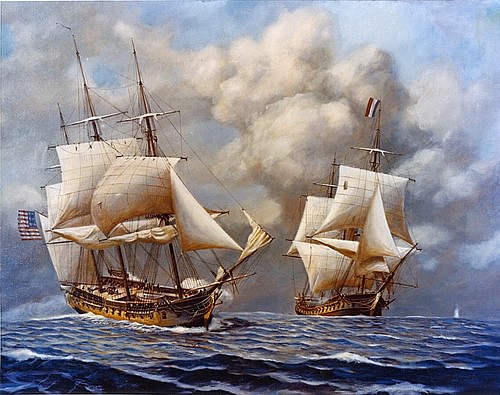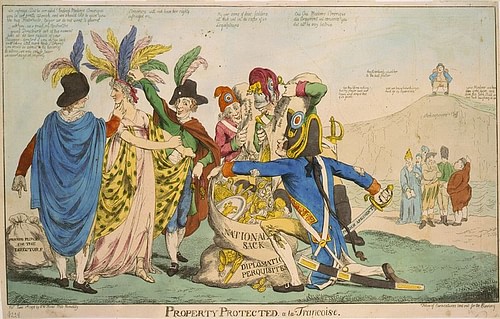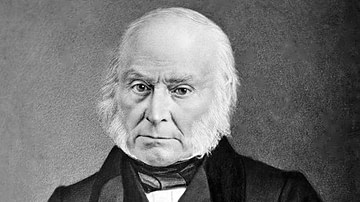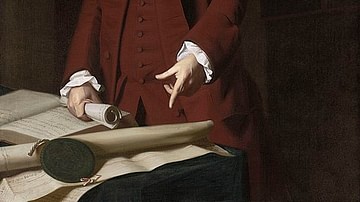
The Quasi-War (1798-1800) or 'Half War' was a limited, undeclared naval conflict fought between the United States and the First French Republic. Hostilities arose when French privateers began attacking neutral American shipping, resulting in several minor naval skirmishes before the conflict was de-escalated in September 1800. The war led to the strengthening of the US Navy.
In 1793, the United States asserted its neutrality in the ongoing French Revolutionary Wars (1792-1802) and decided to suspend repayment of French loans. The following year, it signed the Jay Treaty, which fostered stronger political and commercial ties between the US and Great Britain. Revolutionary France viewed these actions as violations of the 1778 Treaty of Alliance, whereby the two nations had allied against Britain during the American Revolution; in retaliation for this perceived betrayal, France authorized privateers to begin attacking American shipping in the West Indies in late 1796. Within a year, nearly 300 American merchant ships had been captured.
In October 1797, US President John Adams sent a delegation to Paris to negotiate a new treaty and diffuse tensions. This resulted in the XYZ Affair, in which the French refused to negotiate unless the US agreed to pay a large bribe. Outraged, the US began preparing for war. The US Department of the Navy was established, and multiple frigates were commissioned and put to sea, tasked with protecting American merchant ships and hunting French privateers. This resulted in several naval engagements, with the most notable including the USS Constellation capture of the French frigate L'Insurgente in February 1799. Still hoping to avoid a full-scale war, President Adams sent a second delegation to Paris in October 1799. These commissioners had more luck dealing with the new French government, under Napoleon Bonaparte, leading to the Commission of 1800, which ended the war and restored Franco-American relations.
Background
In 1778, the Kingdom of France signed treaties of alliance and commerce with the fledgling United States and entered the American Revolutionary War (1775-1783). France was eager to humiliate and weaken its rival, Great Britain, and duly provided the American rebels with arms, ammunition, uniforms, troops, and ships. French intervention expanded the war into a global conflict, forcing Britain to divert its military resources from North America in order to defend its more valuable colonies in the Caribbean and India. Furthermore, French soldiers and ships proved critical to the decisive American victory at the Siege of Yorktown. When the Treaty of Paris of 1783 ended the war and recognized the independence of the United States, it could be said that French aid had been a key factor in the American victory. Both nations considered the 1778 treaties of alliance to still be in effect.

Then, in 1789, France became embroiled in its own revolution. After the Storming of the Bastille, the revolutionaries gradually eroded the authority of the Ancien Régime until 21 September 1792, when the monarchy was finally overthrown and replaced by the First French Republic. Initially, the French Revolution enjoyed widespread support in the United States, where it was viewed as a continuation of the Americans' own struggle against tyranny. American supporters took to wearing tricolor cockades in solidarity with their French brothers-in-arms, while political clubs called Democratic-Republican societies popped up across the country to praise the Jacobin ideals of 'liberty, equality, and fraternity'. But it was not long before the French Revolution took a radical turn: the deposed King Louis XVI of France was guillotined on 21 January 1793, shortly before the Jacobin government began arresting and executing anyone suspected of counter-revolutionary activity. As it bathed in blood, the French Republic grew bolder and soon sought to spread its revolution beyond its borders; by March 1793, Revolutionary France was at war with most of the great powers of Europe including Austria, Prussia, Spain, the Dutch Republic, and Great Britain. This began a series of total wars that would devastate Europe for much of the next quarter century.
As the French Revolution continued to escalate in Europe, the French revolutionaries looked to the United States for support. They considered the 1778 Treaty of Alliance to still be in effect, as did a large subset of Americans who still supported the Jacobins despite the bloodshed of the Reign of Terror. Thomas Jefferson, leader of the burgeoning Democratic-Republican Party, still referred to the French Republic as 'our little sister' and brushed off the violence, having once said that "the tree of liberty must be refreshed from time to time with the blood of patriots and tyrants”. Jefferson and his supporters (also known as Jeffersonian Democrats) still viewed Britain as an enemy and wanted to support France in its war against the British. In early 1793, France itself sought to whip up support in the United States. Its ambassador, Charles-Edmond Genêt – better known as Citizen Genêt – traversed the country and spoke at Democratic-Republican societies, hoping to rekindle anti-British fervor amongst the American populace. Genêt even went so far as to recruit American privateers to attack British vessels.
Although some Americans supported the French, many others did not. The nationalist Federalist Party was horrified by the chaotic radicalism of the French revolutionaries and feared that similar bloodshed could come to American shores. President George Washington agreed with the Federalists on this point and believed that the United States could not withstand another war with Britain. For these reasons, Washington sought to distance US policy from France. He condemned the actions of Citizen Genêt as incendiary and refused to meet with him, and on 22 April 1793, he issued a Proclamation of Neutrality, wherein he promised to keep the United States out of the French Revolutionary Wars. Around the same time, Congress decided to suspend the repayments of French loans that had been borrowed during the American Revolution; the loans, Congress argued, had been borrowed from the French monarchy which no longer existed and need not be paid to the republic that had taken its place.
Naturally, this was perceived as an insult by the French Republic, but tensions would only worsen the following year. In addition to being anti-French, the American Federalists were generally pro-British; they believed that Britain was the natural ally of the US and sought stronger political and commercial ties between the two nations. This goal was achieved with the controversial Jay Treaty, ratified by Congress in 1795, which resolved some of the issues left over from the American Revolution and fostered trade between the US and Britain. The French were incensed by the Jay Treaty, which they interpreted as a British-American alliance and a betrayal of the 1778 treaties of alliance. In retaliation, France authorized privateers to begin attacking neutral American shipping in late 1796, proclaiming that any American merchant ship carrying British cargo was a valid prize of war. Within a year, nearly 300 American ships had been captured, and their crews were often subjected to maltreatment.
Escalating Tensions
On 4 March 1797, John Adams was inaugurated as the second President of the United States. Almost immediately, he was presented with the issue of French aggression. On 16 May, before a special session of Congress, Adams announced that the French had "inflicted a wound in the American breast” but that it was his intention to heal the shattered friendship between the US and France (McCullough, 484). However, in the same speech, Adams asked Congress to build up the US military, which was almost nonexistent after the demobilization of the Continental Army and Continental Navy at the end of the American Revolution. He did not want a war, but he knew that a stronger US military would add weight to the diplomatic mission he was planning to send to Paris.
In early October 1797, three American envoys – John Marshall, Elbridge Gerry, and Charles Cotesworth Pinckney – arrived in Paris, seeking an audience with the French foreign minister, Charles-Maurice de Talleyrand-Périgord. Talleyrand granted the envoys a brief, 15-minute meeting, during which he derided them for the perceived belligerence of President Adams' speech. After this, Talleyrand dealt with the envoys only through three intermediaries; referred to in coded dispatches as agents 'X', 'Y', and 'Z', these intermediaries told the Americans that no further negotiations would take place until the United States had paid douceur (sweetener) of $250,000 to Talleyrand personally. Additionally, the agents said that the French Republic would require a loan of $10 million as compensation for the 'insults' of President Adams' speech. When the envoys tried to refuse to pay what was clearly intended to be a bribe, agents 'X', 'Y', and 'Z' resorted to thinly veiled threats, stating that any nation not aiding France was an enemy. By April 1798, the talks had broken down, and the American envoys had left Paris.

On 4 March 1798, President Adams received the dispatches from the envoys, alerting him to the incident that would become known as the XYZ Affair. The next day, he went to Congress to announce that negotiations had failed and, two weeks later, formally requested that Congress begin arming vessels and manufacturing weapons. The Democratic-Republicans were outraged by this, with Jefferson referring to Adams' request for a military build-up as 'insane'. But once the XYZ Affair became public knowledge in April, the American public overwhelmingly supported strengthening the military in defense against France. "Millions for defense but not a cent for tribute!” became a popular Federalist rallying cry as more and more citizens clamored for war. On 18 June 1798, Adams appointed Benjamin Stoddert as the first secretary of the navy, and on 7 July, Congress approved the use of force against French ships found in American waters. That same day, Congress also declared all treaties with France were null and void. Adams did not ask Congress for a formal declaration of war, as many Federalists wanted him to, but it seemed as though a major war with France was just over the horizon.
US Military Build-Up
Back in 1794, Congress had ordered the construction of six large frigates to deter Barbary pirates from attacking American trade in the Mediterranean, thereby establishing the US Navy. By 1798, however, only three of these frigates had been completed and put to sea: these included the USS United States, USS Constellation, and USS Constitution (the Constitution is still in commission in the US Navy and remains the world's oldest active warship). Congress appropriated funds for the completion of the remaining three frigates – USS Congress, USS Chesapeake, and USS President – which had all been put to sea by 1800. Together, these ships are remembered as the original six warships of the US Navy. Additionally, Congress adopted several 'subscription ships' into the navy, which were ships that had been privately funded by certain cities. These included five frigates and four sloops.
As it built up its navy, the United States also decided to give France a taste of its own medicine by hiring privateers. Over the course of the war, the US authorized 365 privateers. The largest portion of these privateers came from New England, a Federalist stronghold which had little love for the French. The American privateers were utilized to attack French trade, harass and capture French privateers, and liberate captured American merchant ships. By giving the dirty work to the privateers, the United States freed up their more powerful frigates to escort the American merchant ships to the British West Indies for trade. The presence of even a single US frigate on a convoy expedition was usually enough to deter the French privateers from attacking; with the exception of some French frigates like L'Insurgente, most of the French Navy was occupied off the coast of Europe or in the Mediterranean and could not be spared to help the privateers. The American warships were also sent to patrol the waters around the islands of Guadeloupe and Saint-Domingue, which were often used as havens by French privateers.
In the meantime, the US Army was being built up as well. Former President Washington was called out of his retirement at Mount Vernon to serve as commander-in-chief while Alexander Hamilton was named inspector general, and effectively served as Washington's second-in-command. Hamilton, a prominent Federalist leader, dreamt of turning the United States into a modern, European-like power and saw the escalating Quasi-War as a perfect opportunity to do so; he began drawing up plans for a potential invasion of Florida or Louisiana, which were held by the Spanish (in the European conflict, Spain had switched sides and allied with France, leading to concerns that it would join the hostilities against the US as well). Hamilton worked with Adams' cabinet to secure funding for the army and diligently worked toward its development. When Washington died in December 1799, Hamilton became senior army officer, a position he would hold until 15 June 1800. His plans, however, would be derailed when a peace agreement was finally reached between the US and France in September 1800.
Major Naval Actions
The first significant naval engagement of the war took place on 7 July 1798, the same day that Congress approved military action against French ships. The USS Delaware, a former merchant vessel that had recently been converted into a sloop-of-war, was sailing off the coast of New Jersey when it encountered a French privateer, La Croyable. The Delaware gave chase and ultimately captured La Croyable, which chose to strike its colors and surrender rather than face off against the better-armed sloop. The next day, the American sloop sailed up the Delaware River with its prize in tow; La Croyable was incorporated into the US Navy and renamed USS Retaliation. Commanded by Lt. William Bainbridge, Retaliation was recaptured by the French on 20 November, before being captured by the Americans once again on 28 June 1799.

On 9 February 1799, the 36-gun frigate USS Constellation, commanded by Captain Thomas Truxton, encountered a French naval frigate L'Insurgente off the coast of the Caribbean island of Nevis. The French ship tried to board Constellation, but Truxton successfully maneuvered away and delivered a devastating broadside into L'Insurgente's bow. After two more broadsides, L'Insurgente was too damaged to keep fighting and struck its colors only 74 minutes after the action had begun. L'Insurgente, considered one of the fastest frigates in the French Navy, was repaired and incorporated into the US Navy. Almost exactly a year later, on 1 February 1800, USS Constellation encountered another French frigate, La Vengeance, off Saint Kitts. This resulted in a five-hour engagement that only ended with the onset of darkness. Although Constellation had beaten the French frigate into submission, it was too damaged to pursue as La Vengeance limped off into the night.
End of the War
The naval engagements of the Quasi-War were limited to small, single-ship actions, but the threat of escalation always hung over the hostilities. President Adams still hoped to avoid a major war and, in October 1799, announced his intention of sending a second diplomatic mission to Paris. This decision was opposed by Alexander Hamilton, who argued against making any overtures for peace; Hamilton was confident that the British would prevail in their war against the French and wanted the US to be on the winning side. Adams sat there for hours, listening to Hamilton's reasons against suing for peace, and would later recall: "I heard him with perfect good humor, though never in my life did I hear a man talk more like a fool” (quoted in McCullough, 531). Ultimately, Adams decided to go ahead and send the delegation to France. This would cause a rift in the Federalist Party, as Hamilton had many supporters who also believed peace was a mistake, including those in Adams' own cabinet. The splintering of the Federalist Party over the issue of the Quasi-War would contribute to their loss in the upcoming 1800 election.
By the time Adams' new delegation reached Paris, a new government reigned in France. The old administration, called the French Directory, had been overthrown by General Napoleon Bonaparte in the Coup of 18 Brumaire, an event largely considered to mark the end of the French Revolution. Bonaparte, who now ruled as First Consul, was much more eager to restore good relations with the US than the Directors had been; not only did Bonaparte want to stabilize trade in the West Indies, but he also had no interest in carrying on a meaningless war with the US when he had more important battles to fight in Europe. Bonaparte therefore opened negotiations with the American delegation, and their talks ultimately resulted in the Convention of 1800 – also known as the Treaty of Mortefontaine – which was signed on 30 September 1800.
The Convention formally cancelled the 1778 treaties of alliance and reopened trade between the US and France. No agreement was reached regarding the compensation of American merchants, however, leading many Americans to regard the treaty unfavorably. Most importantly, the Convention of 1800 ended hostilities between the US and France on the high seas. The Quasi-War was over – not only had the fledgling United States proven it could stand up to a European power but now it also had a permanent navy, which would come in handy a decade later when the US went to war with Britain in the War of 1812.








